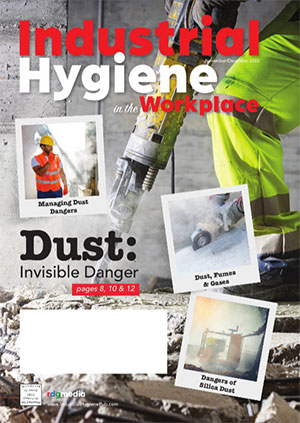“Step Up” Your HazCom Labeling
- How do HazCom (Hazard Communication) labels aid in worker safety?
- OSHA estimates that up to 43 million U.S. workers could be exposed to hazardous chemicals on the job. It is important for these workers to understand the hazards associated with the chemicals they come in contact with. HazCom/GHS labels adhered to containers of hazardous chemicals in the workplace are designed to clearly and consistently communicate the dangers associated with the chemicals; how workers can protect themselves; and what to do if exposed.
- What makes these industrial-strength labels so durable? How do they differ from “other” labels?
- Although standard paper labels and industrial-grade film labels appear similar at a glance, a tremendous amount of R&D and testing goes into creating each product so that it works for its intended application. Most labels are constructed of four key layers: a topcoat, substrate, adhesive and liner. The material characteristics of each of these layers determine how well a label performs in its workspace. Film labels can have a protective topcoat that is waterproof and extremely chemical-resistant in some instances. The substrate is a durable, scuff- and tear-resistant film that is made from materials like polyester and vinyl. The adhesive is permanent. While the topcoat, substrate and adhesive can vary for an industrial label, each adds a level of strength to the entire label “sandwich.”
- To which kinds of surfaces are HazCom labels meant to adhere?
- Adhesion of a label to a surface depends on many factors, including the type of adhesive and the specific surface. Industrial-grade film labels typically use a permanent adhesive that can create a good bond to a variety of surfaces. HazCom labels will typically be used on chemical containers that are made materials such as metal, glass and plastic. It’s always advisable to test the label on the specific surface on which you plan to use it, to ensure effective adhesion. Some labels are tested and certified for specific adhesion. For example, Avery® UltraDuty® GHS labels have passed the 90-day seawater submersion certification test (BS 5609 Section 2).
- The OSHA Hazard Communication Standard (HCS), as of June 2016, requires employers to have updated alternative workplace labeling and hazard communication programs in effect. Chemical manufacturers and importers are required to provide a label that includes a harmonized signal word, pictogram and hazard statement for each hazard class and category. Why is this change so important?
- OSHA updated the HSC in 2012 to conform to the UN’s Globally Harmonized System of Classification and Labeling of Chemicals (GHS). It is important on a couple of levels. One is that it helps workers better understand the hazards associated with the chemicals they are exposed to in the workplace. The second is it strives to harmonize this understanding on a global level as it continues to be adopted in many countries around the world.
- What sort of design elements are important to the labels themselves, i.e., size, color, clarity, etc.?
- A GHS Label has six specific items of data required: the product identifier, signal word, hazard statements, precautionary statements, pictograms and supplier information. There are nine pictogram symbols with red borders that can be used to convey hazard information. In the U.S., there isn’t a strict layout requirement except that the signal word, hazard statements and pictograms should be near each other and that the information on the label must be legible. Information must be presented in English, while other language translations are optional.
- Let’s say I am a customer and I need help creating the right label and getting my labels ordered. How can you help with this?
- Avery has a range of UltraDuty GHS Labels in a variety of sizes for containers like drums pails, jugs, bottles and vials. The labels are waterproof and resistant to chemicals, tears, abrasion and UV fading. The Avery GHS Wizard® online software makes it easy to get the GHS-compliant information onto the label. Users simply type in a CAS number or chemical name and if the chemical is in the database, it will pre-fill the information automatically. Labels can be printed on laser and pigment-based inkjet printers or they can be custom printed using the Avery WePrint™ service.
- How quickly can companies receive their HazCom labels once ordered?
- Avery UltraDuty GHS Labels are available at a wide range of resellers such as Grainger, Fastenal, Staples, Office Depot, Amazon.com, Zoro.com, Avery.com and more. Depending on the reseller, the labels can be delivered as quickly as one or two days. For custom printed GHS labels through the Avery WePrint service, the labels will ship in as few as three business days after artwork approval.
- What can companies do today to step up their safety and labeling game in the workplace?
- With regards to HazCom safety and labeling, here are a few tips:
- Create a written HazCom plan. Keep a hazardous materials inventory and provide access to updated safety data sheets. Train workers to handle hazardous chemicals properly, and update the written plan as needed.
- Label all secondary containers. Using fully compliant GHS labels for secondary chemical containers is ideal because it makes it easier for workers to understand and communicate specific information regarding the physical and health hazards of the chemical – which is required in an OSHA audit.
- With regards to HazCom safety and labeling, here are a few tips:
- Select durable labels. In order to stay compliant, the labels must stay on the containers and remain legible. That is why industrial-grade film labels like UltraDuty GHS Labels, are designed to withstand tough environments.
For more information visit: www.avery.com/ghs
Share on Socials!
Workrite Uniform Company: Top 5 Lab Safety Tips
Protective clothing manufacturer offers recommendations for preventing accidents and injuries in labs. From fires and explosions to sharp objects, pathogens and dangerous chemicals, laboratories are home ...
Read More Pfannenberg Signal Beacons Announced from AutomationDirect
AutomationDirect has added Pfannenberg PYRA and PATROL series heavy-duty signal beacons to its growing lineup of visual and audible signaling devices. These versatile devices can withstand ...
Read More New ANSI/ISEA 121 Safety Standards for Design, Testing and Performance Criteria for Systems to Prevent Dropped Objects in the Workplace
New “Dropped Objects Standards” establishes design, testing and performance safety criteria to guide manufacturers and safety engineers in the production and selection of tethering and lanyard ...
Read More 


